Unfinished Business: Sight Casting to Molokai Bonefish
Sight Casting to Molokai Bonefish with fly rods and inflatable kayaks
Sight Casting to Molokai Bonefish with fly rods and inflatable kayaks … and Natty Lights
Sight Casting to Molokai Bonefish. Every direction was a vision. Golden, shallow flats extended from the western horizon to its eastern counterpart. Waves repeatedly hammered the outer reef to the South. The rippled, folded shoulders of Kamakou to the northeast towered into dark, stormy skies. The good news is we had already caught a few fleeting glimpses of the fish we came for, scarce as they were like needles in a sandy haystack. Up until that point the o‘io, the Hawaiian bonefish, the “gray ghosts” of fly fishing royalty, had remained just beyond the reach of our fly casts.The bad news is it was only our second day on Molokai and we were faced with increasingly adverse conditions. With a frightful forecast ahead, it was greatly evident that we needed a much more disciplined approach to this latest challenge. It would be a test of patience, acceptance and awareness. To put it bluntly, we simply needed to see the matrix. Divine intervention would’ve been welcomed at that point. Hina, the mother of Molokai and the goddess of the moon, surely had remembered us from three years ago as we tirelessly explored these same flats in a similar state of perplexity. Maybe she would step in and give us a boost. Then, in an instant on the afternoon of that second day, what was beginning to feel like another fruitless endeavor became quite the opposite.
The Boys are Back in Town
Sight Casting to Molokai Bonefish. We were up at 5am and on the water at the hint of first light, with copious amounts of coffee consumed in between. It was our early riser wake up ritual. On the first couple days of the trip these vast flats welcomed us with still water, near silence and a chill in the air. It was a shallow, watery world of hope and discovery. The excitement was palpable as dawn turned to day. Yes, we got into some bonefish. We got into some GTs. We got into some milkfish. As a fly fisherman, I’d say our time on Molokai was well spent. And to be honest, it just felt good to be back. Molokai is unlike any other Hawaiian island. It’s unlike any other lonely rock in the entire world. There’s a grit. There’s a timeless beauty. Beneath it all, there’s a peace. A visit to Molokai can be fun and adventurous. But to fully experience Molokai is akin to looking into a mirror in a harsh, revealing light—all the wrinkles and blemishes exposed. There’s rawness to the island. The volcanic, red dirt will stain your clothes. Mud will cake your slippahs. Dust will saturate your pores. Gas prices will dent your credit card. Locals might question your intentions and your pride might take a hit. When you learn their stories and feel the energy of the island, the world you came from will seem smaller and more distant.
Island life is the life! To spend time on an island is a centering experience. From Australia to Maui to Molokai, island hopping has been the norm for me this winter. Having finally landed on Hawaii’s “Friendly Isle” just felt right. As I stepped off that plane in Ho‘olehua the anxiety from Maui, however minimal it was, melted away. It had been nearly three years since our first fly fishing experience on the isolated island. On this most recent visit, however, there was unfinished business. We simply had to give it another go with the resident bonefish. If you haven’t yet read about it, I’m just gonna come out and say it: we got skunked last time. We got skunked when it comes to bonefish, that is. Click here to read about that 2016 trip. When you read about it you’ll not only learn about our bonefish donut, you’ll learn a great deal about the island’s history and culture. As Chasing Scale’s chief writer, I did my best to provide a true sense of place. I felt I needed to give the readers some real substance. Aside from the lack of bonefish success in 2016, it turned out to be one hell of a trip. This recent trip was also “one hell of a trip”, on all accounts.
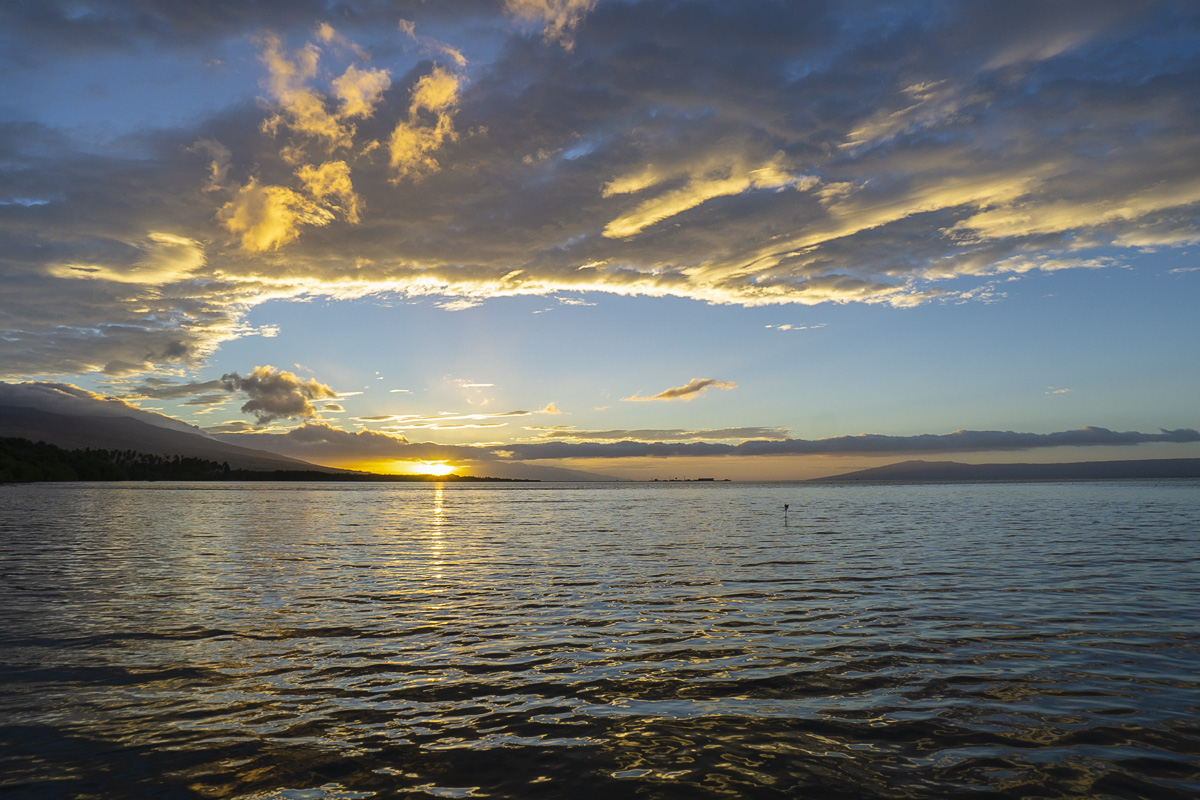
Sunrise on the south shore of Molokai | photo by Brock Munson
Classic Chasing Scale
Sight Casting to Molokai Bonefish. Our last three fly fishing adventures had one common element which rose above all others: gnarly weather. The conditions for fishing were blissful for weeks leading up to the day we arrived in Puerto Montt for our road trip journey through Patagonia last April. In a single day the regional temperatures dropped dramatically while precipitation increased 10-fold. The season for presenting terrestrials to active, hungry trout hit a wall. Nary a grasshopper was to be seen as we rumbled from fishery to fishery southbound toward Tierra del Fuego. The Springtime winds in Western Australia last October were manageable up until our second day into a month-long salt water fly fishing adventure up the west coast from Perth. That’s when the winds kicked up to 25-30 knots, sustained. They continued through the remainder of that incredible trip. Our second visit to Molokai just kept that tumble weed tumbling. Hawaii’s first major winter storm of the year just so happened to move through the islands starting on our second day on the flats. We were engulfed by dark skies, wind and rain. They would last the remainder of the trip. The combination of ceaseless wind, increased surface glare and decreased water temperatures severely reduced our chances of catching a bonefish, let alone other local species. Yep, the odds were stacked against us once again. For us, challenging weather is the norm. Classic Chasing Scale.
Let me clarify—the weather was “gnarly”. It wasn’t “bad”, per se. “Bad” would imply we were trapped indoors. Gnarly weather presents opportunity, though limited. Gnarly weather simply increases the element of challenge to any adventure. And often, it enhances the visual and story-driven content. You can’t have rainbows without rain, right?!

A front moves in from the North | photo by Brock Munson
Molokai No Ka Heke
Sight Casting to Molokai Bonefish. 8 miles. That’s all that separates the islands of Maui and Molokai. Yet, they seem a world away. The gap feels much greater these days without the inter-island ferry operations that ceased a couple of years ago. According to The Maui News, “efforts to keep the struggling commuter and tour business afloat were sunk by competition from federally subsidized commuter air travel” [from an article released October 20, 2016]. Over on Maui you’ll see it on t-shirts. You’ll hear it on the radio. You’ll even hear people say it in regular conversation: “Maui no ka oi” – Maui is the best. On Molokai they have a saying too: “Molokai no ka heke” – Molokai is the greatest. The Molokaians are a proud people. They are humble. They are strong. They are resilient. Isolation is not a new concept for them. It’s widely felt on Molokai that the two neighbor islands are unnecessarily tethered together. Aside from the Kalaupapa Peninsula on the Molokai’s north shore (Kalawao County), Maui and Molokai are connected under Maui County jurisdiction. At the tiny Ho‘olehua Airport commuter airlines ebb and flow all day. Molokai’s unprecedented beauty also draws helicopter tour companies to the island for regular fly-by’s. And they’re not subtle about their operations as they repeatedly blanket quiet, isolated communities with heavy noise pollution without so much as a “mahalo”. I chatted with Thadd, a Molokai resident and good friend, about that noise. He mentioned to me that, in recent years, he made a phone call to one such operator over on Maui in an effort to provide some sound advice to them regarding their reliance on their neighbor island. He thought it would be a good idea for all the various operators to get together in an effort to set up a scholarship fund for local Molokai students as a thank you to the island residents. Not only does the idea seem very plausible, it seems feasible. To me, it’s the least they should do. Thadd, needless to say, was met with less-than-open ears. Hopefully, they’ll do the right thing and give back to the local Molokai communities in the future. After all, the idea of “aloha” is not about taking—it’s about giving with unconditional love, full on.

A momentary laps in wind and rain | photo by Brock Munson
Pregame
Sight Casting to Molokai Bonefish. I flew over from Maui a couple days early to meet up with some local friends. The real fishing would have to wait until Ryan’s arrival a couple days later. This pregame, settling period was a must. I have too much respect for the island to arrive and jump directly into the fishing. The people of Molokai are genuine and true. It’s through the local residents and the blessing of the ‘aina, the land, in which they live that a trip like this is possible. Thadd, whom I mentioned before, is a local tour guide. He also runs a funky, donation-style, car rental business. Born and raised on the island, he seems to know just about all 7,345 residents. Look him up: Molokai Style Borrow a Car. He, along with help from his ten kids, have run the quasi-rental service for years. It’s perfect. It’s local-kine. It’s legal… well, I’m not sure about that last one. We talked story while doing a few chores at his place. He was recently awarded his 40-acre Hawaiian Homestead parcel. The Hawaiian Homes Commission Act of 1920 set aside land for Hawaiian residents with at least 50% native Hawaiian blood for the purposes of perpetuating traditional Hawaiian culture and heritage—a history that had nearly been wiped out after many years of suppression by foreign occupancy. Thadd’s land is a mess and a bit overgrown at the moment. A look around revealed a modest indoor/outdoor 2-room dwelling, an outside kitchen, a piece-meal lanai, a soon-to-be guest house made of multi-colored pallets. Scattered about are various rental vehicles—many obscured by overgrowing weeds. Thadd loaned me a modest, economical rig with brakes and everything. He even let me rig up a roof rack that I pulled from a broken down rust bucket over yonder. The rack didn’t quite fit its new, temporary home so I got some pieces of scrap wood to fill the gaps and some rope and some duct tape for added strength. Good to go! With kayaks “secured” on top, our Molokai cruiser was set to get us where we needed to go, nothing more, nothing less.
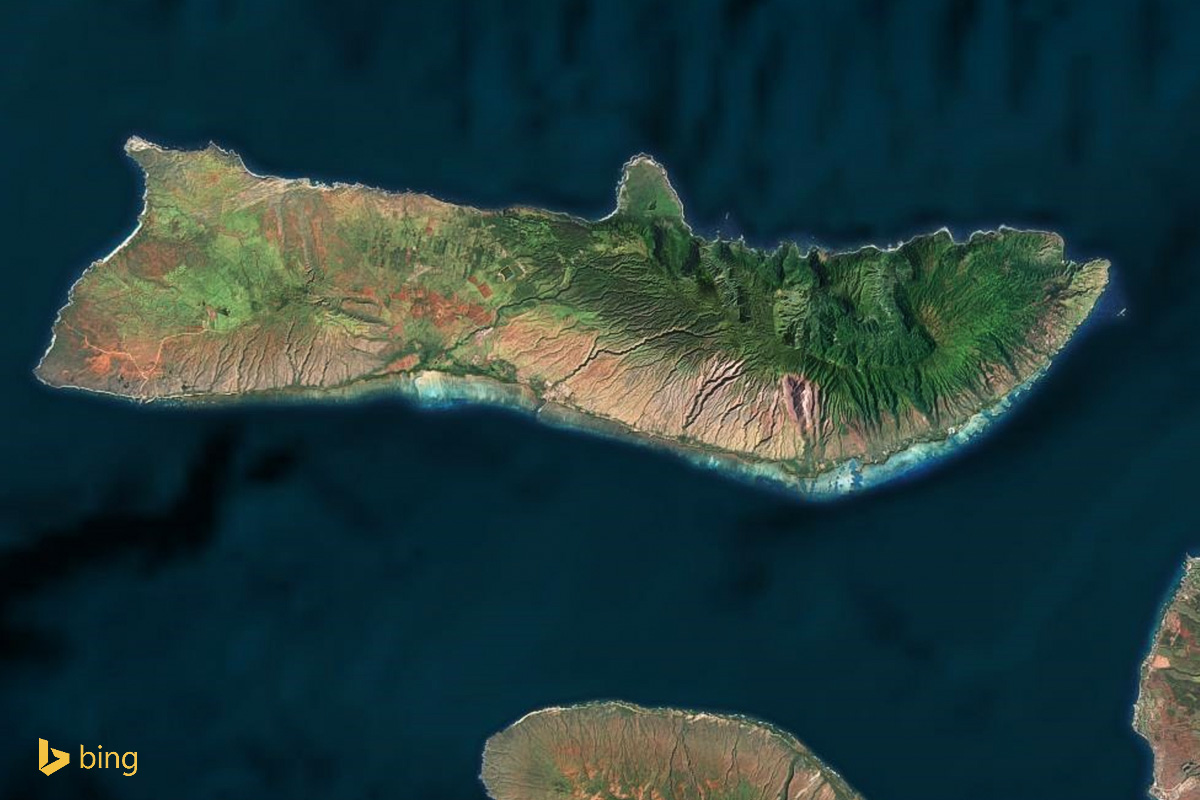
Photo courtesy of bing.com
I got to spend a couple days with Clare who owns Molokai Outdoors. Originally from England she did her share of world travel before ultimately moving to Molokai 25 years ago. An avid water woman, she was a champion windsurfer in her younger years. After reconnecting over wine I got the full rundown on life in Clare’s world. I was reminded of that In Living Color comedy skit—the one about the Jamaican family, “I got eighteen job mon!” She runs her tour business both on the backend and sometimes on the frontline. She’s often busy answering emails, crunching numbers, marketing the business and coordinating the tours, especially during the winter high season. On occasion she also steps in as guide. Along with her tour business, she’s currently studying for her masters in education. She’s training to be a police officer. She’s a realtor. She’s organizes an annual SUP race from Maui to Molokai to Oahu call the Molokai Holokai. Oh, and she’s a single mom. I stayed with her only a couple nights. A restless soul, that one. It’s an understatement to say she’s an inspiration. Three years ago she loaned us a kayak from her fleet. This time we came equipped with our own kayaks thanks to Advanced Elements.

Paddling out from Halawa Valley | photo by Ryan Bonneau
Return to Halawa
Sight Casting to Molokai Bonefish. Did we make it out to the east side? Of course. Twice, in fact—once during my pregame time on island and once after Ryan arrived. This visit to Molokai simply would not be right without a blessing from Pops. Halawa Valley is far from the big hotels. It’s far from the fancy restaurants. It’s far from the touristy luau’s. In Halawa you’ll find a piece of old Hawaii; you’ll find someone who’ll take you back to ancient times. His full name is Pilipo Solatorio and he’s a dedicated son of Halawa. Pops is the oldest living descendant who still lives in the Valley today. In March he’ll be 80 years old, yet his spirit is young and full of energy. He’s the real deal, an authentic Hawaiian cultural practitioner. He holds true to his kuleana, his responsibility, of teaching about the valley’s history and mana, power. This wonderful man has quite a story to tell. And it’s a story that must be heard. It’s a part of Hawaiian history that you won’t find in school books. And it can only come from his mouth—his heart. His son Greg now continues the story with the infectious energy and interpretive skills of a modern, connected generation. Learn more about Pilipo, Greg and Halawa at their website: halawavalleymolokai.com. Did I mention you can hike to a huge waterfall?

Moa‘ula Falls, Halawa Valley | photo by Ryan Bonneau
The Chase is On for O‘io
Sight Casting to Molokai Bonefish. It’s more like a search. I really felt the enormity of the moment. It was an energy that pulsed through my body as the early light of day unveiled the expansive flats on our first day on the water. It was a moment of nostalgia. I dearly missed those flats! Where do we even begin looking for these sparse fish in such a large area? I distinctly remember having this exact thought the last time we were on island. Molokai is a challenging fishery, especially if you don’t know the nuances as the few local guides do. Time spent in search-mode eats up most of the daylight hours. And ultimately, the wind and the tides have the final say. Being in the right places at the right times are moments short-lived in such a fishery. Needless to say, the DIY angler better take full advantage of those scanty, fleeting chances at bones.
Aloha Kakahiaka, Morning Glory
Sight Casting to Molokai Bonefish. Early morning on the flats offers limited sight casting opportunities. It does, however, offer serenity and choice photo ops. The front and backends of a low tide (a couple hours removed from slack low) with the sun sitting low in the sky could provide chances at waking bonefish near the mangroves. You might even catch the sun glistening off a dorsal fin or two as they nose into the substrate for crustaceans next to young mangrove saplings that momentarily breach the surface of the water.

Sunrise paddle on Molokai’s south shore | photo by Brock Munson
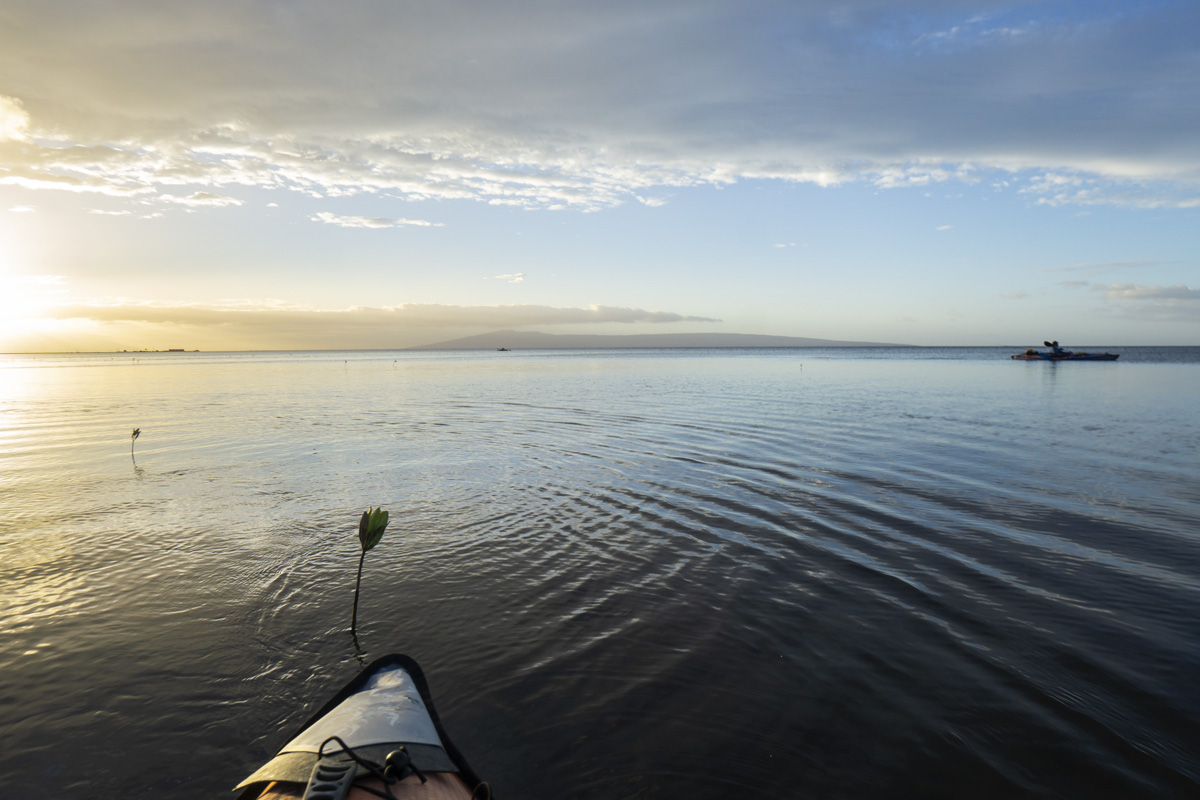
Morning glass with Lana‘i in the distance | photo by Brock Munson

Nearing uncharted waters for Chasing Scale | photo by Brock Munson
Midday Bliss, Aloha Awakea
Sight Casting to Molokai Bonefish. The prevailing, northeast trade winds that regularly grace the island chain are usually blocked by Kamakou, Molokai’s eastern extinct volcano. All 4,961 mountainous feet do a pretty good job of sheltering the majority of the southern coastline. As the day progresses into the afternoon hours, those same winds tend to strengthen and can often wrap around the mountain obscuring the fish with increased surface turbidity. Needless to say, the stronger winds also bring challenges to casting. If Konas (winds out of the southeast) move into the island chain these same challenging conditions are omnipresent. With no mountain to block them, these winds can last from morning to night. North winds sometimes rip across the central, low-lying region of the island blanketing the flats with cold wind. If these weather patterns persist, they can greatly decrease the water temps which can, in turn, decrease the bonefish activity on the flats. North winds almost always bring clouds, rain and glare on the water!

Low tide on Molokai’s south shore | photo by Ryan Bonneau
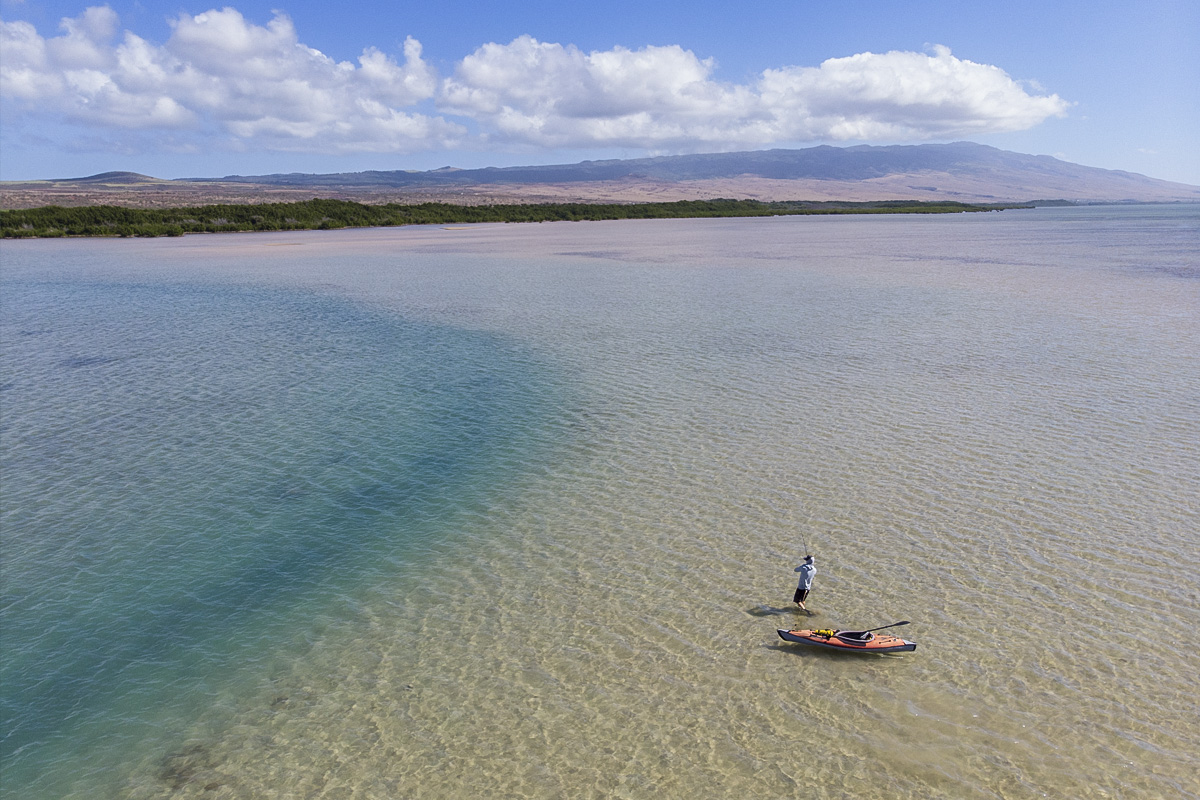
Milkfish on! | photo by Ryan Bonneau
Evening adversity, Aloha Ahiahi
Sight Casting to Molokai Bonefish. Unless the wind drops, all probability of landing a bonefish on the fly goes way down as the day approaches evening. As the sun nears the western horizon, visibility goes to zero. That doesn’t mean you give up completely. Never take your rig apart until you’re officially off the flats for the day. It’s definitely a time to break out the camera for some ridiculous sunset action. But be ready to make a quick cast. If that wind dies, keep an eye out for wakes in shin-to-knee deep water. It might seem as if the bonefish have left the flats. But you’ll think otherwise when you unexpectedly spook a few. They’re still doing their thing regardless of whether you’re seeing them or not.

Cold and wet at the blissful end to a challenging day on the flats | photo by Ryan Bonneau
Rigging Up, Hawaiian-style
Sight Casting to Molokai Bonefish. Let’s nerd out for a moment. It’s always the first question before planning a fly fishing trip to Hawaii, or anywhere for that matter: rod size? If you’re chasing bonefish on the flats you can get away with an 8-wt. And an 8-wt sure does feel nice when you’re out there all day. But, this ain’t the Bahamas where the bonefish are like sheep. Because the gray ghosts here are much more scarce, sight casting opportunities are limited. I prefer to use a 9 or even a 10-wt in Hawaii. I’m not a local guide, but I have made enough casts to have an informed opinion. There’s a good chance you won’t be cracking the whip all day long and putting that wrist through the ringer. You can get away with a heavier rod and you just might be glad you did when you get into the pigs.
More important is leader size. Yes, it’s true—the bonefish are spooooooky in Hawaii. You gotta fool these buggahs. But I wouldn’t rig up with anything less than 15lb flourocarbon. I’ve seen online tips advising tippet as light as 12 lbs. Personally, I wouldn’t chance it. Yes, you’ll have better odds of fooling these beefy, stealthy torpedoes with lighter tippet but they will more-than-likely break you off, especially around the sharp stuff. It is a subtropical ocean after all. And yes, there is coral, though less prevalent the closer you are to the mangroves. The areas near the outer reef have a lot more coral. And, guess where the bonefish tend to run when they’ve taken your fly? You guessed it, offshore toward the outer reef. Spend the money and bring flourocarbon. They are strong fish, as the species tends to be no matter where you are. The Hawaiian versions average 5-7 lbs but can grow to over 10 lbs. Maybe it’s the poi. Who knows. But, they’re big! Check your drag. Make sure your reel is ready to scream. Cheehooooooo!
Less important is fly size—light colored shrimp and crab patterns (match the substrate whenever possible) in size 4 or thereabouts. Let it sink and settle. Give a small-kine twitch or two (less is more). For the love of Hina, don’t over sell it! These bonefish are quick to say “aloha” without so much as a shaka if they encounter something that doesn’t look natural.
Backing—this is super important. Rig up with a minimum of 150 yards. If you’re lucky enough to hook one of these Hawaiian bonefish, it’ll take you for a ride! With time and dedication on the flats you might just get a chance at the big boys.
Shoots! A Surprise!
Sight Casting to Molokai Bonefish. It was early afternoon on our first day. Things were quiet. We were approaching low tide on a sunny day so the colors were vivid and mesmerizing. The wind wasn’t howling, yet. Ryan decided to launch the drone for some scenic footage. Not distracted by the buzzing camera above me, I kept my eyes focused on the water. I wasn’t yet fully acclimated to sighting fish on the flats but that didn’t detour my concentration. That’s when I spotted a flash. It was a school of 3 or 4 fish. I couldn’t quite tell the species with the rippled surface only allowing very limited detail. But, I had bonefish on the brain. So, I approached with that mindset. They cruised up into the shallows from a bluer, deeper water channel. My small, bushy, tan-colored shrimp pattern settled perfectly in their path about a 4 feet from them. Twitch — twitch — take. One took the fly. I’m not even sure the fly had a chance to fully settle on the substrate. None the less, fish on! Instead of making long runs as bonefish are known to do, this fish fought with powerful, sporadic short bursts. The drone captured the fight and the triumphant grip-n-grin (I was grinning underneath my Buff). It was a beautiful milkfish known in Hawaii as awa. It was an incredible catch, but not the species we had come for.
We got out of the wind and explored a cove that had promising mangrove habitat during the low tide. As far as the mangrove habitat was concerned, it was the deepest water along the fringes of the twisted vegetation that we had encountered yet. Seemed like a promising place for bigger fish to seek refuge during low water levels on the flats. And, I’ve heard that it’s not improbable to find bonefish in such a habitat. But, the odds were we’d find other species—perhaps some jacks or trevally. We were hoping for an omilu (bluefin trevally) or, by the grace of God, an ulua (GT’s). Ryan cast into some murky water along the edges of some thick mangroves. Wouldn’t you know it—he landed a small jack. Moments later he landed something bigger: a young GT.

Love for this surprise milkfish, Hawaii awa | photo by Ryan Bonneau

GT caught off the kayak | photo by Brock Munson
Right Place, Right Time
Sight Casting to Molokai Bonefish. Right tide. Right wind. Right sun. Right depth. Right amount of Natty Light consumed. It was early afternoon on our second day when my luck with bonefish on those golden flats changed in an instant. It was about an hour before low tide. We were in shin deep water on a section along the southern flats where I had spooked a few bones earlier in the day. I crossed my fingers that maybe, just maybe, it was a honey hole. So, Ryan and I decided to rendezvous our Advanced Elements kayaks about 100 yards from the mangrove-laden shoreline. We cracked a couple beers and scanned the area. The setting seemed perfect. But the fish activity remained quiet, at least for the moment. It was during the second beer that Ryan, like a little girl at a pony, pointed in earnest at something behind me. I knew that look well. He made a couple casts with no success. It turned out to be a couple cruising bones. They swam off quickly. I took the opportunity to tie on a new fly, deciding on a size 4, orange/tan Gotcha—my go-to. It was only 10 minutes after Ryan had spotted the pair that I noticed some cruisers moving in. Their path led directly and dangerously to my location. Not good. The fish were on a mission. I had to work quick for risk of spooking them. After a 40-foot errant cast, I was able to get a second (this time 30 feet) one off as the fish slowed a little but stayed on course. That second cast was on target. The fly landed and settled nicely maybe a foot in front of them. I wanted desperately to strip. But, I allowed the fly to settle like a feather on a windless day. With one quick yet subtle twitch, one of the fish moved toward the fly with vigorous burst. I had him. The line went taught and the next thing I knew he took it toward the outer reef precariously close to the forest of massive coral heads. Hina must’ve been watching over me. She must’ve decided that after all my fruitless efforts, it was my time. After four or so heavy runs I had a majestic Molokai o‘io in hand. It wasn’t the biggest we had seen out there, but in my eyes it was pure, ghostly perfection—a trophy in the world of fly fishing. I couldn’t stop staring at its sleek scales as they tapered down the lateral sides in perfect, shimmering rhythm It was the largest bonefish I had ever caught, and probably the most beautiful. I am aware that I probably say that each and every time I catch a bonefish.
With not a moment to re-rig a new fly, let alone check my knots, another bonefish moved in. And in seconds, I had another one on. This one was bigger than the first. It took my line even further out off shore than the first. It tested the full capacity of my backing. Then, all tension was gone. It broke me off. 5 minutes later, Ryan had one on. His broke him off too. When it rains it pours. In a span of 20 minutes we had reached bonefish bliss. Then, as quickly as the activity turned on, it turned off. We wouldn’t see a moment like that for the rest of the trip. The skies grew dark later that afternoon. North winds brought rain and colder water temperatures. The inclement weather and the challenging conditions that followed would set the tone for the remainder of the trip. But nothing will ever take away that briefest of bonefish bliss on that miraculous afternoon.

Moments before the release of a big bonefish | photo by Ryan Bonneau

The author remains calm as elation wells up inside | photo by Ryan Bonneau
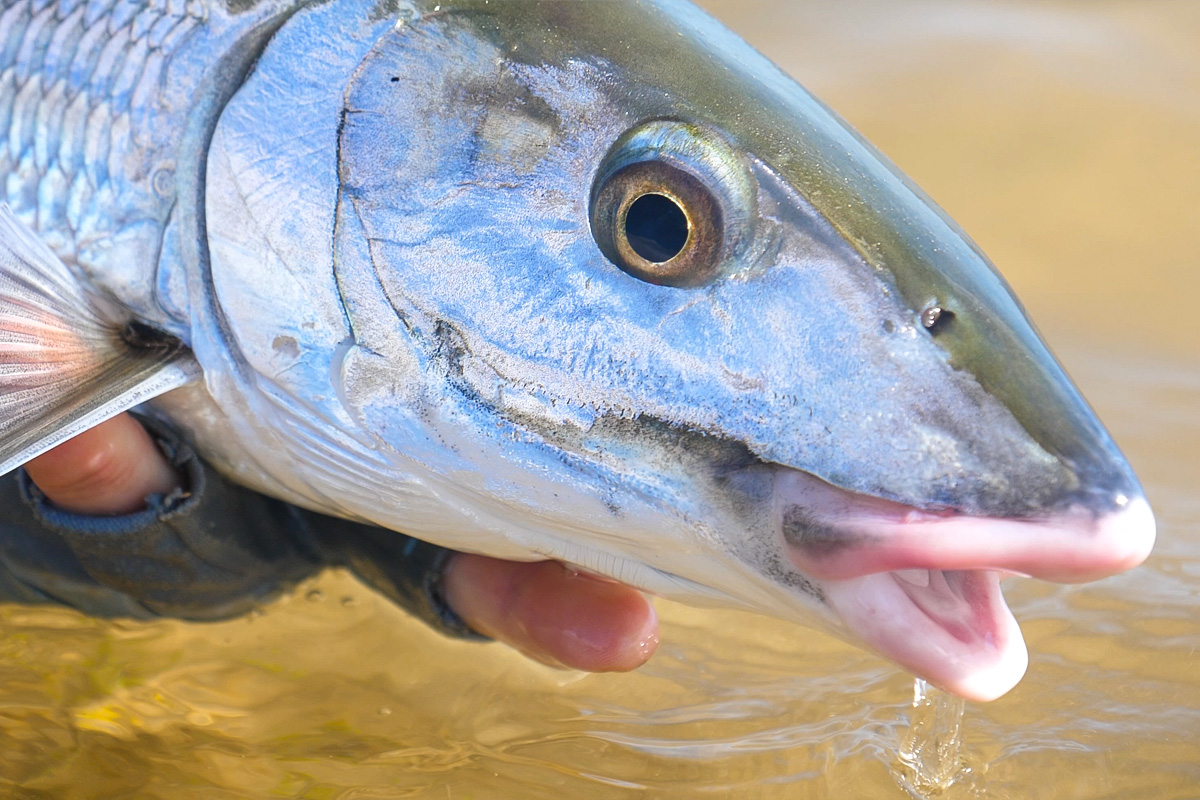
The most beautiful bonefish these eyes have ever seen | photo by Ryan Bonneau
Molokai no ka heke.
Truth.
A hui hou kakou.
Until we meet again.
Story by Brock Munson
Photos by Ryan Bonneau and Brock Munson
cofounders, Chasing Scale
Brock is the lead writer at Chasing Scale • brockmunson.com
Ryan Bonneau is the lead photographer at Chasing Scale • ryanbonneauphoto.com
Continued bonefish education and some fun reads:
- bonefishtarpontrust.org
- bonefishhawaii.com: blog post | conservation
- saltwatersportsman.com
- wheretraveler.com

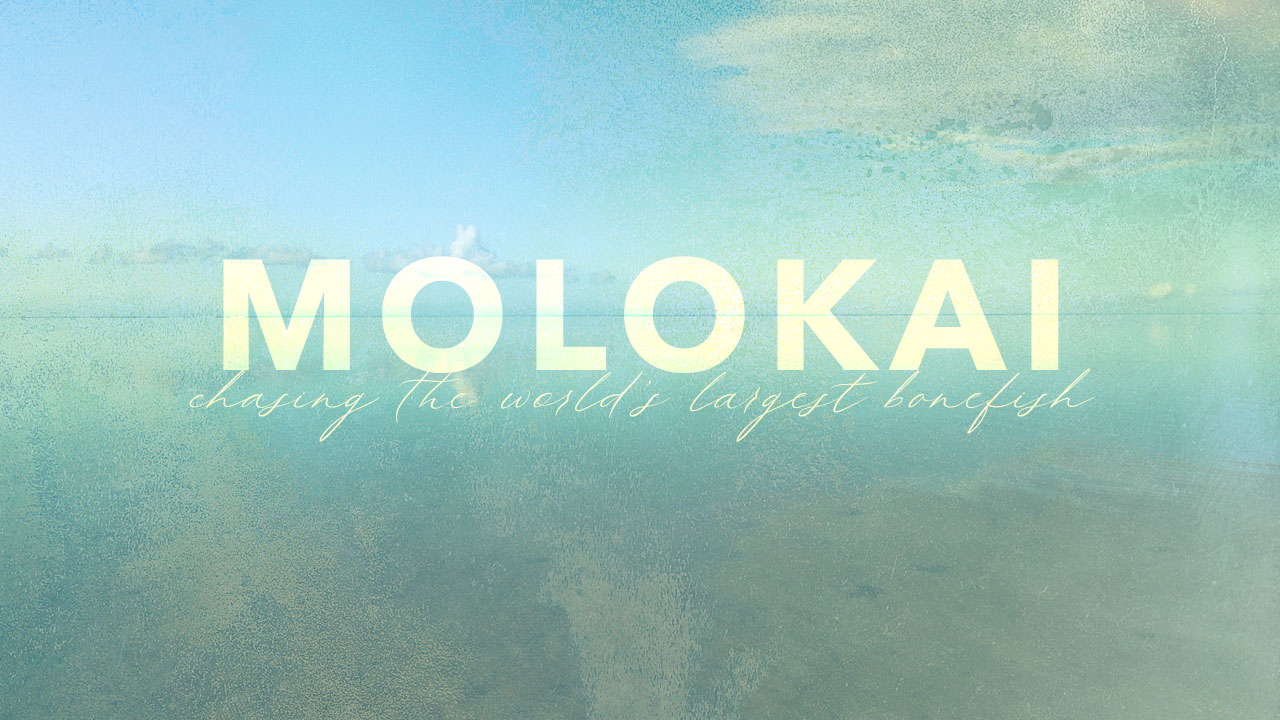

The photos are beautiful and the read is also very enlightening!
Thanks Mom!